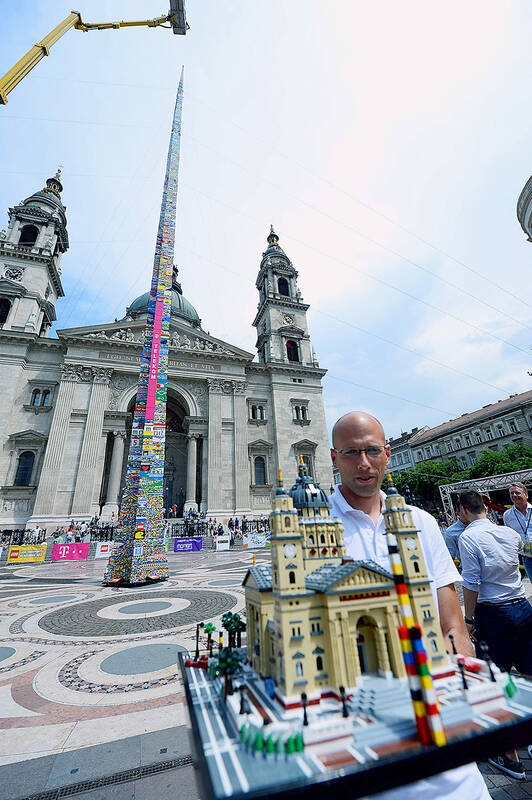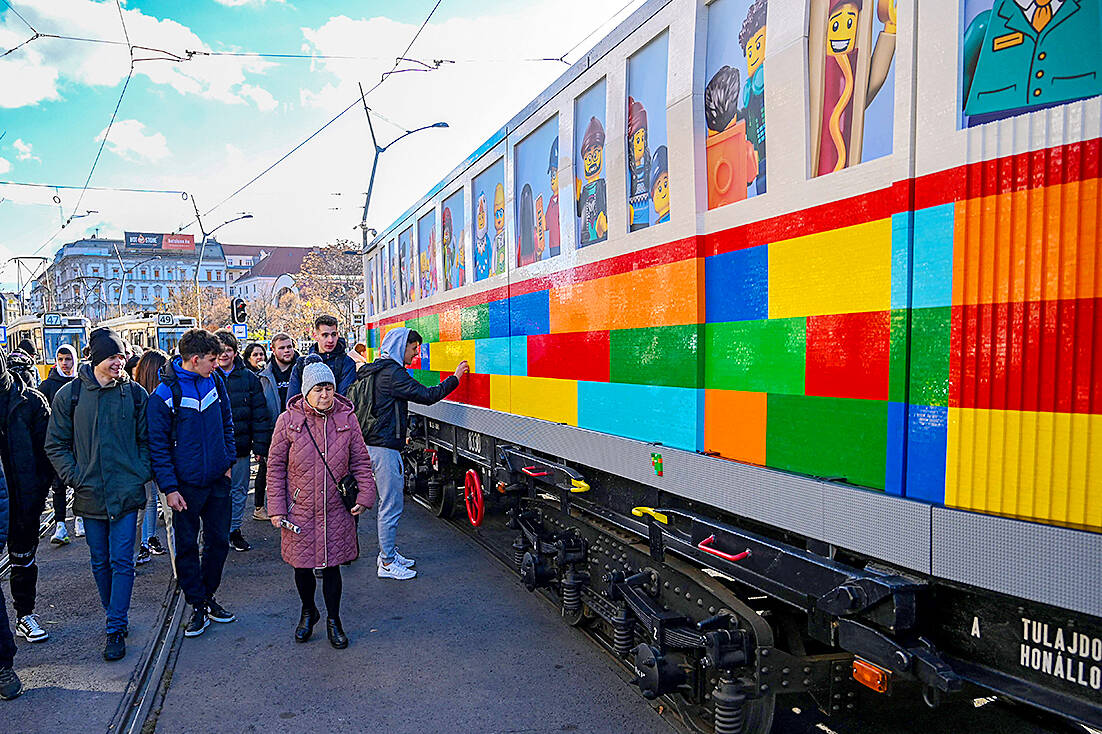To build his giant Lego structures which usually take hundreds of thousands of bricks, Hungarian artist Balazs Doczy first must solve major “engineering challenges.”
“Every structure has an Achilles’ heel. Once it is solved, the rest of the work is easy,” the 48-year-old said.
He needed 90 helpers for one of his most recent works — a life-sized Lego tram made up of a staggering 1.8 million pieces.

Photo: AFP
Together they put in around 6,800 hours to assemble Doczy’s most ambitious project that is now on display in a bustling square in central Budapest.
The 11-meter-long Lego tram — commissioned by Budapest’s transport companies and its tourist office to “public transport and creativity” — has attracted droves.
“We’ve never seen anything like this before,” said Malaysian tourist Lucas Chang, 32, while dance coach Barbara Rajnai said children in her son’s and daughter’s kindergarten told them to check it out.

Photo: AFP
‘MEGASTRUCTURES’
A professional Lego artist for more than 10 years, Doczy works more like an architect than a builder, relying on specialist software to draw up plans and only assembling bricks when he needs to test out a particular design.
“Initially, I do preliminary sketches much like a painter, stacking bricks on each other in a digital environment,” he said.
“I set up the scale, identifying recognizable elements and proportioning the other parts relative to that.”
For his intricate dioramas, such as his model of the Heroes’ Square in Budapest, every piece has to imitate a specific detail.
In “megastructures” such as the tram, imperfections even as small as a tenth of a millimeter could stack up, leading to instability, he said.
“I always compare it to quantum mechanics and gravity: in a smaller scope matter behaves differently than on a grander scale,” he said.
Thus blocks are glued together, an internal frame is added for extra support and experts are consulted to ensure structural integrity.
Doczy also added some baseplates on its sides to allow people to place their own Lego bricks, which “has always appealed to me, because it allows anyone to express their creativity and transform the sculpture into a community piece.”
Doczy was fascinated with Lego at an early age, assembling bricks with his older brother, though Western products were in short supply in then-communist Hungary.
“We begged the neighbor’s kids to bring their sets too, so we could build bigger structures. We had ambitions even back then,” Doczy recalled.
His childhood passion was reignited years later when his nephew became captivated by the colorful blocks.
When he looked at his brother, “our eyes lit up and we realized we should start building again,” Doczy said.
Moving back to Hungary from Indonesia — where he had been teaching diving — he and his brother set up a business called “Brick Workshop” in 2013 to create Lego designs and organize activities for children and adults.
‘TOO VALUABLE TO THROW’
In 2014, Doczy’s Lego model of Budapest’s iconic St. Stephen Basilica was featured at a Guinness World Record attempt, when volunteers constructed the world’s highest Lego tower at the time in front of the basilica.
Three years later, he was officially recognized as a “Lego certified professional” (LCP) by the Danish company.
The coveted title — currently held by around two dozen creators — is awarded to talents who “create stunning, innovative designs that help push the boundaries of creativity and engineering,” a Lego spokesperson said.
The perks are being able to regularly consult with other LCPs and access Lego’s sculpting software that allows Doczy to order “from the 14,000 different pieces in production,” he said.
But for some projects, he has to scour the thriving second-hand market to search for pieces. Luckily for him, even bricks from the 1970s can be found there.
“As a diver, I’ve never seen Lego bricks pulled out of the sea,” said Doczy, who divides his time between Budapest and the Spanish island of Mallorca. “They are just too valuable to be thrown away.”

June 2 to June 8 Taiwan’s woodcutters believe that if they see even one speck of red in their cooked rice, no matter how small, an accident is going to happen. Peng Chin-tian (彭錦田) swears that this has proven to be true at every stop during his decades-long career in the logging industry. Along with mining, timber harvesting was once considered the most dangerous profession in Taiwan. Not only were mishaps common during all stages of processing, it was difficult to transport the injured to get medical treatment. Many died during the arduous journey. Peng recounts some of his accidents in

“Why does Taiwan identity decline?”a group of researchers lead by University of Nevada political scientist Austin Wang (王宏恩) asked in a recent paper. After all, it is not difficult to explain the rise in Taiwanese identity after the early 1990s. But no model predicted its decline during the 2016-2018 period, they say. After testing various alternative explanations, Wang et al argue that the fall-off in Taiwanese identity during that period is related to voter hedging based on the performance of the Democratic Progressive Party (DPP). Since the DPP is perceived as the guardian of Taiwan identity, when it performs well,

The Taiwan People’s Party (TPP) on May 18 held a rally in Taichung to mark the anniversary of President William Lai’s (賴清德) inauguration on May 20. The title of the rally could be loosely translated to “May 18 recall fraudulent goods” (518退貨ㄌㄨㄚˋ!). Unlike in English, where the terms are the same, “recall” (退貨) in this context refers to product recalls due to damaged, defective or fraudulent merchandise, not the political recalls (罷免) currently dominating the headlines. I attended the rally to determine if the impression was correct that the TPP under party Chairman Huang Kuo-Chang (黃國昌) had little of a

A short walk beneath the dense Amazon canopy, the forest abruptly opens up. Fallen logs are rotting, the trees grow sparser and the temperature rises in places sunlight hits the ground. This is what 24 years of severe drought looks like in the world’s largest rainforest. But this patch of degraded forest, about the size of a soccer field, is a scientific experiment. Launched in 2000 by Brazilian and British scientists, Esecaflor — short for “Forest Drought Study Project” in Portuguese — set out to simulate a future in which the changing climate could deplete the Amazon of rainfall. It is